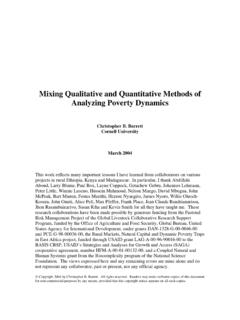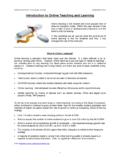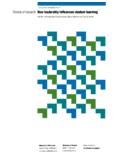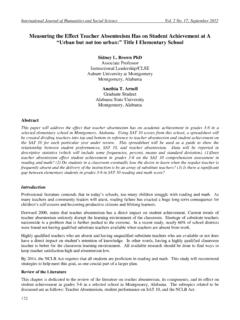Transcription of Causes of low academic performance of primary school ...
1 REGIONAL CONFERENCE ON EDUCATION IN WEST AFRICA DAKAR, SENEGAL 1ST 2ND NOVEMBER, 2005 Causes of low academic performance of primary school pupils in the Shama Sub-Metro of Shama Ahanta East Metropolitan Assembly (SAEMA) in Ghana by Dr. Kafui Etsey Department of Educational Foundations University of Cape Coast Cape Coast, Ghana 1 INTRODUCTION Shama Ahanta East Metropolitan Assembly (SAEMA) is one of the district assemblies in the Western Region of Ghana. It is one of the three metropolitan assemblies in the country. The other two are Accra-Tema and Kumasi. SAEMA is located about 210 kilometres along the coast, west of Accra and is divided into three sub-metro district councils which are Shama, Sekondi and Takoradi. The twin city of Sekondi-Takoradi is both the district capital and the regional capital.
2 The Shama sub-metro is made up of Shama and Inchaban circuits. The poor academic performance of pupils in the Shama sub-metro of the Shama Ahanta Metropolis has been a concern for the metropolitan assembly over the past few years. The schools have shown poor performances in all public examinations and as one director puts it, their BECE results have been appalling . The schools in the sub-metro have been performing poorly in the national performance monitoring tests administered by the Ghana Education Service and they have also performed consistently poorly in the Metro mock Basic Education Certificate Examinations (BECE). Daramanu (2004) reported that: A study of the 2003 BECE results gives the following appalling picture. The Shama Circuit presented 427 candidates, i. e. 226 boys and 201 girls. Out of this number only 5 had aggregate 7-15.
3 Another 135 obtained an aggregate from 16-30, whilst the remaining 287 scored aggregate 31 and over. In the Inchaban Circuit there were 593 candidates altogether. Only 7 candidates scored aggregate 7-15, 215 scored aggregate 16-30, whilst 371 had aggregate 31 and above. No candidate scored aggregate 6 in the whole Sub-Metro. So out of the total of 1020 candidates presented by both Shama and Inchaban Circuits, 658 failed; only 12 did well to gain admission to the well-endowed Senior Secondary Schools. This situation is indeed pathetic. The situation as described above is a great problem since the Ghana Government has initiated programmes such as the Free Compulsory Universal Basic Education (fCUBE) with the view to improving the quality of the educational system.
4 Through the fCUBE program the Ghana Government seeks to ensure that all citizens are equipped with the fundamental knowledge and skills that will enable them to be full stakeholders in and beneficiaries of development. The pathetic situation in the Shama sub-metro has alarmed the metropolitan assembly and the assembly has been seeking ways to research into the Causes of the poor academic performance in the Shama sub-metro. 2 Several factors have generally been identified as Causes of poor academic performance . Agyeman (1993) reported that a teacher who does not have both the academic and the professional teacher qualification would undoubtedly have a negative influence on the teaching and learning of his/her subject. However, he further stated that a teacher who is academically and professionally qualified, but works under unfavorable conditions of service would be less dedicated to his work and thus be less productive than a teacher who is unqualified but works under favorable conditions of service.
5 Neagley and Evans (1970) were of the view that effective supervision of instruction can improve the quality of teaching and learning in the classroom. Etsey, Amedahe and Edjah (2004) in a study of 60 schools from peri-urban (29 schools) and rural (31 schools) areas in Ghana found that academic performance was better in private schools than public schools because of more effective supervision of work. Another factor is motivation . A highly motivated person puts in the maximum effort in his or her job. Several factors produce motivation and job satisfaction . Young (1988) examined the job satisfaction of Californian public school teachers in the USA and found that one of the overall job predictors was the salary one earned from it. Studies by Lockheed et al. (1991) indicated that lack of motivation and professional commitment produce poor attendance and unprofessional attitudes towards students which in turn affect the performance of students academically.
6 The availability and use of teaching and learning materials affect the effectiveness of a teacher s lessons. According to Broom (1973), the creative use of a variety of media increases the probability that the student would learn more, retain better what they learn and improve their performance on the skills that they are expected to develop. Ausubel (1973) also stated that young children are capable of understanding abstract ideas if they are provided with sufficient materials and concrete experiences with the phenomenon that they are to understand. Class sizes have also been identified as determinants of academic performance . Studies have indicated that schools with smaller class sizes perform better academically than schools with larger class sizes. Kraft (1994) in his study of the ideal class size and its effects on effective teaching and learning in Ghana concluded that class sizes above 40 have negative effects on students achievement.
7 Asiedu-Akrofi (1978) indicated that since children have differences in motivation , interests and abilities and that they also differ in health, personal and social adjustment and creativity generally good teaching is best done in classes with smaller numbers that allow for individual attention. 3 Butler (1987 has also found homework to be a correlate of academic performance . He stated that homework bore a positive relationship with learning outcomes when it is relevant to learning objectives, assigned regularly in reasonable amounts, well explained, motivational and collected and reviewed during class time and used as an occasion for feedback to students. Churchill (1965) found a positive relationship between the location of a school and the student and teacher performance . The presence of all or some of the factors identified above may have resulted in the poor academic performance of pupils in the Shama sub-metro.)
8 However, evidence of the availability of these factors as well as other factors need to be obtained. The purpose of this study therefore is to obtain evidence of the factors that are responsible for the poor academic performance of pupils in the Shama sub-metro. Specifically, the study sought to answer the following questions? 1. What school environment factors are the Causes of poor academic performance in the Shama sub-metro? 2. What teacher factors contribute to the low academic performance of the pupils in the Shama sub-metro schools? 3. What pupil characteristics are responsible for their poor performances in the Shama sub-metro? 4. What parental support variables cause pupils in the Shama sub-metro schools to perform poorly academically? METHODOLOGY Research design The basic design used in this study was causal-comparative (ex post facto).
9 In the causal-comparative or ex post facto research, the researcher attempts to determine the cause, or reason for existing differences in the behaviour or status of groups of individuals (Gay, 1996). When it is observed that groups differ on some variable, the researcher attempts to identify the major factor that has led to this difference. Causal-comparative studies are important in education because several educational variables cannot be manipulated and be used for experimental research. The main concern in this study was to identify the differences between the SAEMA high achieving schools and the Shama sub-metro low achieving schools in terms of school environment, teacher, pupil and parental variables. These variables include availability of textbooks, regularity in school , teacher professional qualification, payment of school fees, 4and provision of infrastructure, teaching and learning materials and children s basic needs as well as language use.
10 To achieve the purpose of the study, questionnaires were administered and interviews conducted between 28th June and 2nd July 2004. Confidentiality of responses Efforts were made to maintain confidentiality of the responses. Participants were told that their responses would be kept confidential and that no one known to them would have access to the information provided and no one can link the data to their names. Sample A sample of 25 primary schools was used in the study. This was made up of 15 Shama sub-metro schools and 10 SAEMA high achieving schools. The high achieving schools were selected by the results of the 2003 BECE examinations and the 2001 performance Monitoring Tests (PMT). The 15 Shama schools were randomly selected from the list of 35 primary schools. Table 1 provides a summary of the sample distribution.












